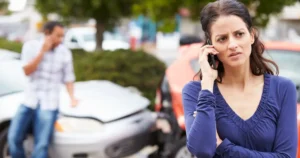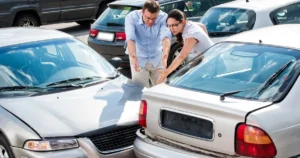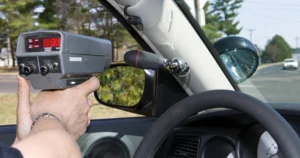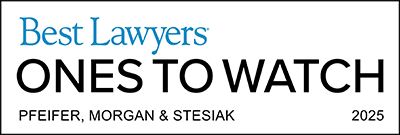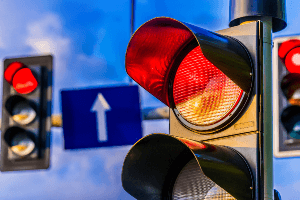 According to the National Highway Traffic Safety Administration (NHTSA), red-light running crashes account for about 22 percent of all intersection-related accidents in the United States.
According to the National Highway Traffic Safety Administration (NHTSA), red-light running crashes account for about 22 percent of all intersection-related accidents in the United States.
If you were injured in an accident caused by a driver running a red light, you have the right to pursue compensation for your damages from the liable party.
Below, our South Bend car crash attorneys discuss how liability is determined and what your legal options may be. If you have any questions about your claim, call us today to schedule a free consultation.
What Are the Most Common Types of Red-Light Accidents?
Red-light accidents can occur in various ways, including the following:
- T-bone collisions – Also known as side-impact crashes, these occur when a vehicle traveling from one direction strikes the side of another vehicle crossing its path. These crashes are common when one driver runs a red light and another vehicle is crossing the intersection at the same time.
- Rear-end collisions – Generally, these collisions do not involve one driver running a red light. Instead, these crashes usually occur because one driver came to a stop at an intersection with a red light, while a rear driver did not.
- Pedestrian and cyclist accidents – When a driver disregards a red light, he or she may collide with a pedestrian or cyclist in the crosswalk. These red-light collisions are usually common when a driver is making a turn.
Understanding the common types of red-light accidents may help determine the cause of the collision, which in turn may help establish who is at fault for the crash.
Why Do Drivers Run Red Lights?
One of the leading causes of red-light accidents is distracted driving. When drivers are engaged in activities such as texting or talking on the phone, their attention is diverted from the road. As a result, they may fail to notice traffic signals, including red lights. This failure to stop is a common cause of collisions in an intersection.
Red-light accidents can also occur when drivers engage in reckless behaviors, such as speeding or aggressive driving. Drivers who are in a hurry may choose to run a red light instead of waiting for it to change. Speeding can make it difficult to stop in time when approaching an intersection, especially if the driver fails to anticipate the traffic signal turning red.
Impaired driving is another reason why drivers might run a red light. Driving under the influence of alcohol or drugs significantly impairs a driver’s judgment, reaction time and decision-making abilities. Intoxicated drivers may ignore red lights or fail to notice them. This negligent behavior can cause devastating accidents when they enter an intersection.
When drivers fail to yield the right-of-way at intersections, they can cause red-light accidents. This often happens when drivers are inattentive or misjudge the timing of the traffic signal. For example, a driver making a left turn may enter the intersection without yielding to oncoming traffic, leading to a collision with a vehicle that has the right-of-way.
What Role Does Negligence Per Se Play in a Red-Light Crash Case?
Negligence per se is a legal standard that can significantly impact red-light crash cases. It establishes that if a person violates a law designed to protect public safety, and his or her violation causes injuries, his or her actions can be considered negligent per se.
In the case of red-light crashes, if a driver ran a red light and caused an accident, he or she likely violated traffic laws and regulations. This violation can serve as strong evidence of negligence, making it easier for your attorney to establish fault.
How Can I Prove Another Driver Ran a Red Light?
Many intersections are equipped with traffic cameras that capture video footage of the intersection and the vehicles passing through it. This footage can serve as strong evidence if it clearly shows a driver disregarding the red light. Your attorney may be able to contact the appropriate transportation department to obtain the traffic camera footage.
If there were witnesses at the scene of the accident, their testimony can also be valuable in confirming that the driver ran a red light. Eyewitnesses who observed the incident can provide statements detailing what they saw, including whether the driver failed to stop at the red light.
Physical evidence at the accident scene can provide insights into the driver’s actions as well. Skid marks or specific damage patterns on the road or vehicles involved in the collision can indicate that the driver failed to stop at the red light. These findings should be included in a police officer’s report, which can then be used as evidence or by an accident reconstruction expert who may be able to help determine whether a driver ran a red light.
What Are My Legal Options After a Red-Light Crash?
Indiana is an at-fault state, which means accident victims must file a claim with the liability insurance of the driver who caused the collision.
Your attorney should be able to negotiate with the insurance company on your behalf to recover the compensation you need for medical bills, lost wages and other damages.
However, if the insurance company refuses to pay out your claim, you have the right to file a lawsuit to recover your damages.
Contact an Experienced Attorney Today
Our attorneys have decades of experience helping accident victims take legal action against negligent parties and successfully recovering compensation.
We do not charge any upfront fees for our services. Our clients only pay us when we win.
Call (574) 444-0741 to schedule a free consultation.

